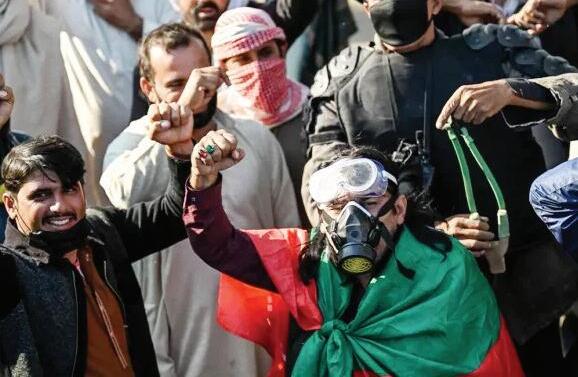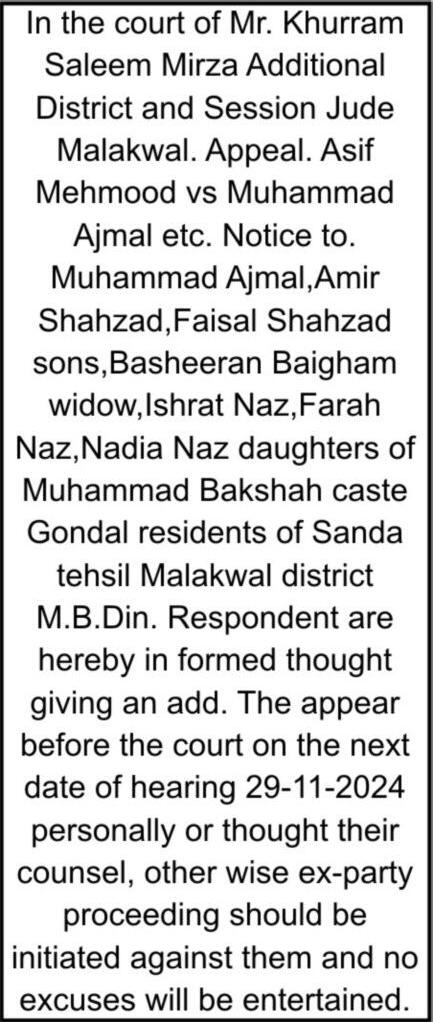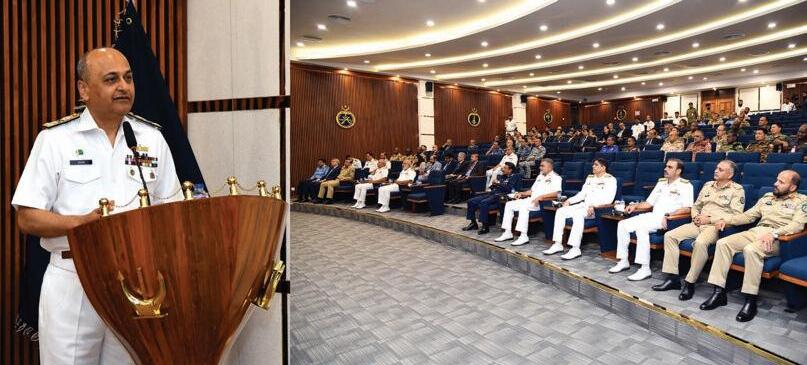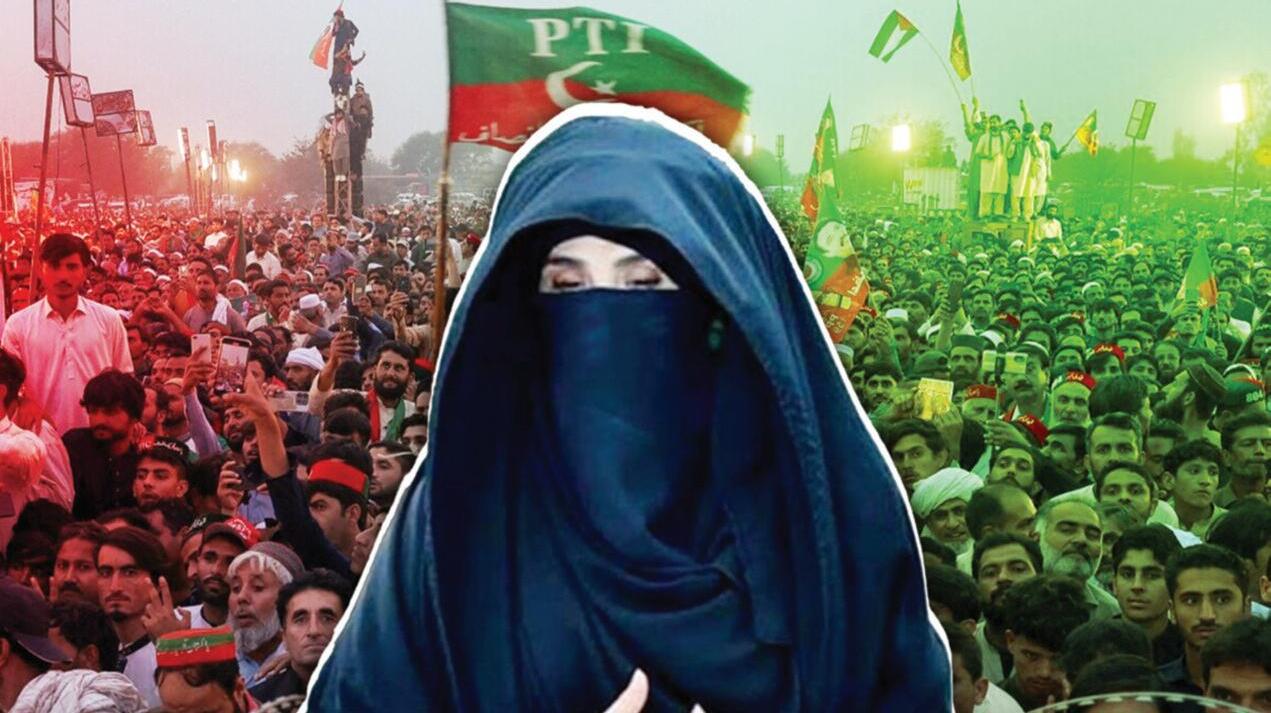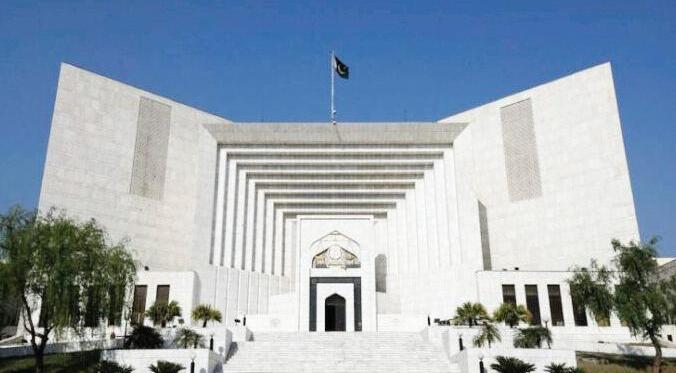Pakistan, Belar us FMs reaffir m commitment to promote mutually
beneficial cooperation
situation in the Middle East They expressed their support for a peaceful resolution of conflicts and underlined the need for a coordinated approach to address the humanitarian situation in Gaza
The two sides emphasized the importance of enhanced cooperation in international and regional organizations to advance mutual interest and jointly address global challenges
Punjab minister says policeman killed by ‘violent’ PTI protesters
two days to block the protesters whom jailed PTI founder Imran Khan has called on to march on parliament for a sit-in demonstration to demand his release, while highways into the city have been barricaded The government has used shipping containers to block major roads and streets in Islamabad most of them patrolled by
ISLAMABAD: Pakistan Tehreek-e-Insaf (PTI) spokesperson vehemently denounced
Probe launched into alleged irregularities in recruitment at standards control authorit y
period due
outflows imposed by
transmission companies
in
system According
published by
citing
Ministry
leading E&P firms including OGDCL Mari
PPL and MOL have repeatedly warned authorities that curbing gas flows from wells to protect the gas transmission network could lead to irreparable damage Wells nearing depletion are particularly vulnerable as reduced flows could permanently impair their output requiring costly investments in artificial lift methods to restart production Data indicates that several wells have already sustained damage from such practices, resulting in significant financial losses
Since November 13 2024 Sui Northern Gas Pipelines Limited (SNGPL) has reduced gas outflows by 285 mmcfd further endangering gas fields Latest data shows reductions of 90 mmcfd from PPL s Sui field, 22 mmcfd from OGDCL’s Qadirpur field, 48 mmcfd from Mari Petroleum’s HRL/Ghazij field and several other fields experiencing similar cutbacks
The country s main gas pipeline system is now functioning as a storage facility rather than a transport and distribution network due to plummeting gas consumption particularly in the power sector SNGPL reports that power plants are consuming less regasified liquefied natural gas (RLNG) than allocated, leading to high system pressure Despite mitigation efforts, the situation persists, with the power sector utilizing only 174 mmcf of RLNG for electricity generation
The government has already deferred five LNG cargoes slated for 2025 to the following year in response
to reduced demand While Pakistan imports 10 LNG cargoes monthly power plants often underutilise the supply Power Division officials attribute this to cost-saving measures, as RLNGbased electricity generation costs Rs26 per unit, significantly higher than power generated from local gas coal nuclear or hydropower plants
In November 2024 electricity demand has dropped driven by cooler weather reducing air-conditioning use, particularly in Punjab, KP, and northern regions As of November 24, the national line pack stood at 5 159 bcf slightly lower than the 5 174 bcf recorded the previous day Indigenous gas input into the system was 481 mmcf, while RLNG input totaled 699 mmcf, with Sui Southern retaining 64 mmcf for its network
E&P companies are calling for immediate action to address these issues cautioning that continued reductions in gas outflows could lead to long-term damage to Pakistan s energy infrastructure
The Public Procurement Regulatory Authority (PPRA) has rejected a request from the National Database and Registration Authority (NADRA) to exempt acquiring Software Development Kits (SDKs) and desktop/server machines from procurement rules BR reported citing sources that the equipment was intended to enhance the efficiency of the Pakistan Online Visa System (POVS) The Ministry of Interior sought the exemption in an October 11, 2024, let-
ter, citing directives from the Prime Minister s Office to resolve technical issues in the visa system NADRA argued that the SDKs were crucial for improving the system’s capabilities such as detecting fraudulent passport details verifying fingerprints and performing facial liveness checks on iOS, Android, and web platforms The request was made under Section 21 of the PPRA Ordinance 2002 for exemption from Rules 21 and 36 of the Public Procurement Rules 2004 claiming the urgency of the procurement justified bypassing the usual com-
petitive process NADRA emphasized that the Federal Government had recently revamped the visa regime simplifying requirements and introducing Visa Prior to Arrival (VPA) for 126 countries to boost investment and tourism
However, after thorough deliberations, the PPRA Board unanimously ruled that the exemption was not justifiable Instead it advised NADRA to use alternative procurement methods permitted under Rule 20(N) of the Public Procurement Rules, provided all relevant conditions were met The board’s decision underlines the need for compliance with procurement regulations even in cases of urgency while ensuring transparency and accountability in public acquisitions
projects to prioritize those that can be completed within a reasonable timeframe
The government has decided to phase the Public Sector Development Programme (PSDP) over three years to prioritize highimpact projects and align with the International Monetary Fund (IMF) requirements
This step is part of a broader strategy to address the Rs9 trillion development portfolio under the $7 billion Extended Fund Facility Dawn reported citing sources that a meeting, chaired by Planning Minister Ahsan Iqbal, focused on streamlining the PSDP, which, without intervention, would take over 14 years to complete at the current pace The meeting emphasized aligning with IMF-mandated conditions initiating a one-time review of approved
Intellectual decline in the age of social media
Both nations must collaborate to address the complex global challenges we face. History suggests the US has little reason to fear China. After all, China is not the nation that dropped two atomic bombs on Japan or launched an average of 46 bombs per day between 2001 and 2021, culminating in an estimated 326,000 bombings across nations like Iraq, Syria, Afghanistan, and Yemen. These figures donÊt even account for drone strikes, missile launches, or artillery attacks.
Decades old roads
Touseef aHmed
itized over the written word The rise of shortform video platforms has further diminished the patience required to engage with books Statistics reveal a grim reality: libraries are closing, and bookshops are struggling to survive The book-to-screen ratio in the average household has reversed dramatically When was the last time families discussed a classic novel around the dinner table? Today the conversation is more likely about the latest trending drama or influencer scandal Social media has birthed a new genre of content that profits at the cost of societal values Family vlogging, for instance, exposes the private lives of children for public consumption often without their consent Children are commodified for likes and revenue their childhoods sacrificed for views Similarly, drama culture thrives on toxic narratives, unrealistic portrayals of relationships, and glorification of shallow ideals Women, in particular are disproportionately affected The perpetuation of regressive stereotypes be it the overly submissive daughter-in-law or the scheming rival has deepened societal divides rather than bridging them Social media amplifies such narratives, making them accessible to millions in a matter of seconds The normalization of these toxic portrayals erodes the intellectual and moral fabric of society Women bear the brunt of social media s darker side Unrealistic beauty standards perpetuated by influencers lead to body image issues, while dramatized content reinforces outdated roles Instead of empowering women, much of the digital content confines them to traditional and often harmful stereotypes A study by the Dove Self-Esteem Project
found that over 70% of young girls feel pressure to meet beauty standards set by social media The mental health repercussions are profound ranging from anxiety to depression Intellectualism, which once advocated for equality and empowerment, is now overshadowed by superficial narratives that perpetuate these crises
The question remains: How do we reclaim intellectualism and rebuild a society grounded in knowledge and empathy? Parents and educators must prioritize reading Initiatives like book clubs, public libraries, and community reading events can rekindle the love for books among youth Governments and tech companies must collaborate to monitor and restrict content that commodifies children or perpetuates stereotypes Campaigns that celebrate intellectual achievements rather than appearances can redefine beauty and success for women Schools should incorporate media literacy programs to teach students how to analyze and question the content they consume online The battle for intellectualism in the digital age is far from over While social media has undeniably changed the way we communicate it should not come at the cost of eroding our intellectual and moral values Books, ideas, and critical thinking are the lifelines of any thriving society Let us not allow the fleeting allure of viral content to overshadow the enduring wisdom of books and intellectual discourse The youth our future leaders deserve a world where their minds are nourished, their ideas are valued, and their identities are not reduced to mere hashtags In reclaiming our intellectualism, we reclaim the essence of humanity itself
The writer is a freelance columnist
Bouk
Hadia aHmed


rooted in Einstein’s General Theory of Relativity Musk referred to the concept of creating a “warp bubble” that contracts space in front of a spacecraft and expands it behind effectively allowing the craft to traverse vast distances without exceeding the speed of light within its local frame This concept, known as the Alcubierre Drive, was proposed by physicist Miguel Alcubierre in 1994 It suggests that by warping spacetime a spacecraft could achieve effective Faster-Than-Light (FTL) travel without violating the laws of physics Elon Musk is captivated by this theoretically possible feat and is actively working on advanced propulsion technologies and leveraging artificial intelligence (AI) to solve complex challenges Reports suggest that Musk has created an AI supercomputer known as Colossus located in Memphis Tennessee It is equipped with 100 000 of the latest Nvidia GPUs, liquid-cooled with massive water systems, and powered by Tesla Megapack batteries According to Musk, Colossus is not merely a machine but a gateway designed to fuel “Grok ” an AI model capable of propelling humanity beyond the boundaries of human understanding Musk envisions Grok solving some of humanity s greatest mysteries, such as the enigma of black holes, dark matter, and dark energy He believes we are on the verge of unlocking the secrets of the cosmos or perhaps discovering something even more unimaginable waiting for us on the other side In another video Elon Musk shared an
In another video, Musk described a hypothetical scenario involving a spaceship that could take you to distant stars in the blink of an eye . This concept, known as the „warp drive , ‰ involves a revolutionar y way of thinking about travel. Instead of zooming through space , a warp drive would work by stretching space in front of the ship and compressing it behind. Musk illustrated this concept by likening space to a giant rubber sheet.
idea that showcased his deep understanding of cosmology, explaining it in simple terms rather than relying on complex mathematical calculations or difficult-to-comprehend concepts He stated that while technically traveling faster than the speed of light might be theoretically possible it remains a difficult feat to achieve at this point in time He explained this by highlighting how space itself can play tricks on us While we cannot travel faster than the speed of light the fabric of space is moving at speeds faster than light In another video Musk described a hypothetical scenario involving a spaceship that could take you to distant stars in the blink of an eye This concept, known as the “warp drive,” involves a revolutionary way of thinking about travel Instead of zooming through space a warp drive would work by stretching space in front of the ship and compressing it behind Musk illustrated this concept by likening space to a giant rubber sheet Imagine pulling a distant star closer to you instantly By pulling the space in front of you closer and pushing the space behind you away you could move forward without physically moving This means it would be possible to travel to other planets and even distant stars faster than light all without breaking the laws of physics
Reaching this point of understanding and innovation has not been easy for Elon Musk When he first introduced the concept of commercial space exploration the entire world seemed to turn against him During a Congressional Senate hearing in 2010 many veteran space legends including Neil Armstrong, publicly opposed the idea of commercial space exploration Musk later revealed that this opposition brought him to tears However this criticism did not deter him Today SpaceX is approaching a $250 billion valuation and has conducted more than 400 launches over the past 14 years including 15 crewed missions Of these, ten were under contract with NASA to transport astronauts to the International Space Station (ISS)
Under President elect Trump a major shake-up in U S space policy began to take shape There are discussions about potentially canceling future iterations of NASA s Space Launch System (SLS) or even abandoning it altogether Plans for Gateway, a proposed space station in lunar orbit, were also reconsidered in favor of expanding commercial contracts with companies like SpaceX This shift aimed to accelerate efforts to send humans to Mars a vision Musk has championed for years Musk s ultimate goal is to colonize Mars His vision includes building up to 1 000 Starships a year to transport people between Earth and the red planet As in the

Under President elect Trump, a major shake-up in U.S. space policy began to take shape . There are discussions about potentially canceling future iterations of NASAÊs Space Launch System (SLS) or even abandoning it altog ether. Plans for Gateway, a proposed space station in lunar orbit, were also reconsidered in favor of expanding commercial contracts with companies like SpaceX. This shift aimed to accelerate effor ts to send humans to Mars, a vision Musk has championed for years.
past, this ambitious idea is not without controversy Many conventional scientists caution that it will require years of further research and development as the technologies necessary to sustain life on Mars do not yet exist However just as Neil Armstrong and others once doubted the feasibility of commercial space exploration, these conventional scientists may not be able to deter Elon Musk from venturing into this arena Musk has a track record of defying skepticism as demonstrated when many believed rockets could not and would not land back on their launch pads Musk proved them wrong by stating that if a rocket can ascend along a specific trajectory, it can also descend along the same path to return to its launcher Once again Musk’s determination may turn the improbable into reality


in the headlines reinforcing the Indian government claim Is it conceivable that the government of a nuclear power with the fourth-largest military in the world and Great Power aspirations does not have the capacity to check an easily verifiable fact? The event is extraordinary because the media, especially television media, in the largest democracy in the world went along with this deliberate misinformation not because of incompetence but because large sections of the mainstream media have become mere government messengers
GOVERNMENT LENS: The post-liberalisation era in India, with the corporatisation of the media, has seen a spectacular erosion of the press as the fourth estate of democracy The Narendra Modi-led era has added another dimension in which Hindutva has enveloped the media Scholars argue that television media employs complex communicative frames to relate to their audience Increasingly, mainstream Indian television journalism relies on dominant frames, that is,
posing and multiple perspectives especially of those who are marginalised The collective interests of the nation-state and its elites who are upper class/caste cultural recognition of a homogenised majoritarian nationalism and mythic tales of the greatness of the Hindu nation have become the frames that characterise Indian media coverage Of course, there is little scope for the exposé/investigative frame that interrogates the government itself
This bias has been in full visibility in the media coverage of the India-Canada diplomatic row since 2023: a complete toeing of the government line without questioning the impact on diaspora populations of the bravado of “New India’s” alleged targeted killings of “enemies” overseas or spreading of disinformation about these developments
The voices featured on TV are those who represent Indian – or rather Indian government interests (these are not always the same) The Canadians who are invited are Canadian government critics, either genuine critics or propagandists They are merely there to reinforce the official Indian view It is amusing that the same Canadian critics appear on every Indian TV channel The rare Canadian dissenting voice is reduced to the status of the Pakistani guests on news anchor Arnab Goswami s show
‘KHALISTANIS VS HINDUS’: This dominant frame of Hindutva and the nation-state played out in the violence at a Hindu temple in Brampton in Canada earlier this month Journalists rushed to share videos – including unverified ones – framing them as “Khalistani groups on the rampage and Khalistani violent extremist mob seeking out Hindus
These videos played out in an endless loop on countless channels and the social media accounts of journalists, evoking anger in India and producing a swift condemnation by the Indian prime minister The event became theatrical and sensational and what scholar Daniel Dayan calls a “media event”: great news events speak of accidents of disruption Here the disruption is of the nation and of the (Hindu) nationalist community Here, media frames of contest and contention only belong to Khalistanis, a category to which all Sikhs are reduced TV news debates have no diaspora voices who represent Hindus who are not Hindutva supporters
There is no media attempt at pursuing the facts –even while acknowledging that truth cannot be established only by social media videos Initial short videos that journalists shared showed that both the Khalistani and Hindu/nationalist groups were involved in a violent clash, using sticks and flag poles, rather than just Khalistani groups attacking unarmed Hindu groups Later longer videos show that the confrontation began outside the temple as Khalistani supporters chanted anti-India slogans against a consular camp held within the temple They were challenged by Hindu supporters and a fight broke out The Hindu group retreated into the temple premises, chased by the Khalistani groups Nevertheless, the unlawful entry of Khalistani supporters into the temple premises has to be unequivocally condemned
All this context disappears in a media narrative that is framed only around a Khalistani attack on a Hindu temple when ironically the Indian diplomatic press release itself mentions violent disruption outside consular camp There was also a complete media blackout of Hindutva groups indulging in violence against property, possessing weapons and inciting violence – which included a Hindu priest from the same temple – against Sikh temples in retaliation Even when reported it is reported as Canadian police fac[ing] criticism for arresting only Hindu protestors This is another framing device: the complete inaction by the Canadian police against Khalistani lawbreakers
In reality, arrests of violent Khalistani protestors had already been made within a few hours of the first instance of violence evidence was sought for ongoing investigations and further arrests were made including of a prominent Khalistani activist The Indian media s obfuscation is dangerous as far-right Canadian politicians do not distinguish between Khalistanis and Hindu nationalists and use these incidents to fuel anti-immigration sentiments
Rather than educating readers and viewers about the Air India bombing by Khalistani extremists and asking very legitimate questions about the failures of the Canadian government, the media has spread misinformation such as claiming that nobody was convicted for the Air India bombings – when, in reality, Inderjit Singh Reyat, the bomb-maker, spent nearly 30 years in a Canadian jail
The media similarly ignored the fact the mastermind of the bombing Talwinder Parmar could not face trial in Canada as he had been killed allegedly in a police encounter in India
Most shockingly, there has been a complete media silence about the fact that Ripudaman Singh Malik was removed from an Indian travel blacklist in 2019, and that he in turn had praised the Modi government Who was Malik? A key Canadian Khalistani conspirator in the bombing that took 329 lives
The Canadian court that had acquitted Malik for want of foolproof evidence to convict him for mass murder, nevertheless, had refused to declare him innocent A major Indian newspaper, which has routinely pilloried the Canadian government for harbouring Khalistani terrorists called Malik a “Sikh leader”
India s fears about Khalistani-backed terrorism are genuine However the Indian media has odiously fanned the scourge of religious extremism by focussing disproportionate attention on the Khalistani movement overseas, even though experts attest that it is virtually dead in India In a 2021 Pew survey, 95% of Sikhs were “very proud to be Indian” Even the small uptick in fatalities in the last few years is associated more with criminal gangsterism
Qamar Bashir
A F T E R 2 9 K I L L E D I N B E I R U T
CPEC’s crucial role in Pakistan’s growth in face of obstacles
still hangs over the na-
tion s hopes for development Pakistan has suffered an incredible financial cost as a result of terrorism
Economic Corridor (CPEC), have transformed as engine of development and global connectivity
The China-Pakistan Economic Corridor aims to connect China s western regions with South Asia and the Arabian Sea via Pakistan’s Gwadar Port As a result, the CPEC was referred to as the Belt and Road Initiative s (BRI) flagship project These programs reflect a shared vision of prosperity by enhancing economies, boosting regional connectivity and fortifying international ties For Pakistan CPEC is more than just a path to success; it is a lifeline to economic stability and progress
However there are other challenges that might compromise this journey s potential including terrorism and disinformation efforts Pakistan nevertheless confronts a number of challenges on its path to prosperity despite these positive developments
The most important of these is the persistent threat of terrorism, which
Over the previous 20 years terrorism is thought to have caused the country to lose more than $126 billion in economic damages Due to the perception of instability international investors are reluctant to commit to large-scale projects which causes critical infrastructure and economic efforts to be postponed The human price is equally as high Thousands of innocent people have been killed in acts of terror upending families and wreaking havoc in local communities
There is an unfathomable psychological cost to living under constant risk as many inhabitants feel trapped in a vicious cycle of uncertainty and terror A purposeful campaign of disinformation and propaganda against CPEC is compounding these difficulties The project has been aggressively targeted for undermining by certain Western media outlets and neighbouring nations, who have referred to it as a “debt trap” or a geopolitical instrument for Chinese domination
The development of Pakistan cannot take place without stable peaceful environment
Some western media and neighboring media nega-
tive propaganda against CPEC is a hurdle in long term development of Pakistan and as well for peace and stability and improving common Pakistani life
Some unseen obstacles and foreignfunded vicious demonstrations have brought halt to the development of Pakistan which has resulted in bad economy and inflation as well poverty Because of terrorism many innocent citizens have lost lives
However, these assertions frequently lack foundation and are motivated more by geopolitical conflicts than by dispassionate analysis Pakistan s growth is seen by several neighbouring governments as a danger to their own regional aspirations Their geopolitical calculations are upset by a stable and prosperous Pakistan especially when it comes to influence and commerce They so turn to disseminating false information in an effort to cast doubt on the advantages of CPEC
Stories that emphasise possible dangers over real advantages have also been spread by Western media While conveniently disregarding the long-term economic benefits and the reality that many CPEC projects are organised through joint ventures rather than loans, critics point to Pakistan’s mounting debt burden
ISLAMABAD




